- 1946 Buick
- A Pair of 1938/39 Cadillacs
- 1930 Ford
- M.G. TC 1946
- 1959 Morris - Minor 1000 (Traveller)
- 1924 Rolls Royce
- 1934 Rolls Royce Phantom II
- Vauxhall 12
Tab 1

1946 Buick
Brief History
Inventor David Dunbar Buick saw his first motor car around the turn of the century and remained obsessed with cars all his life. He was to eventually form a partnership with William C. Durrant. They founded a company that later became General Motors Corporation of America, one of the most successful car-making empires in the world. Over 17,000,000 cars bearing the Buick name and crest have rolled off production lines.
Buick built his first engine in 1901 and followed in with an overhead value version in 1902 with a better engine. By 1903 there was a demand for cars and the Buick Motor Company started production. The series 40 was introduced in 1936 when car sales were escalating rapidly and it went on to become the best selling car in the U.S.A. In 1939 Buick were the first to replace the Semaphore arms with the flashing indicator.
In the post war years there was a demand for luxury products and Buick Super was launched. With its shining chrome interior it was known as ‘Jaws’. The Buick super four-door sedan with its superior technical than features became more popular than the already fashionable Ford.
A 1946 Buick (RJY-19) can be seen in The Palace Udaipur The Vintage & Classic Car Collection.
| Buick Eight | Super |
| Registration No. | RJY-19 |
| Model | 1946 |
| Engine | Straight 8 |
| BHP | 144 |
| Transmission | 3+1 Manual |
Tab 2
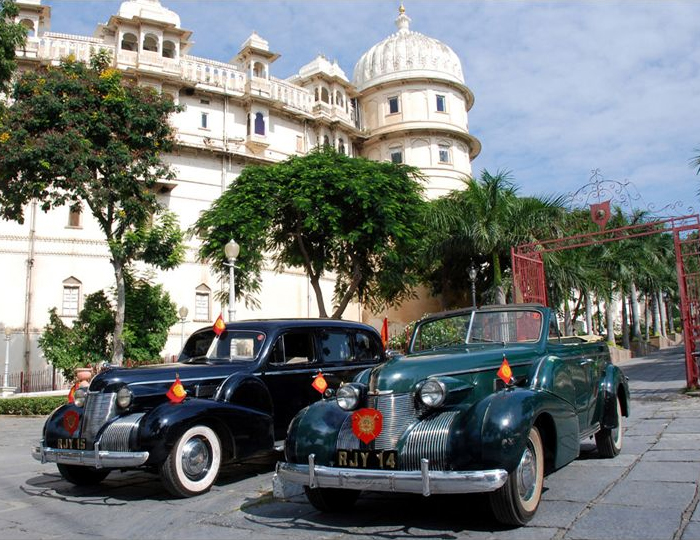
A Pair of 1938/39 Cadillacs
Brief History
In 1914 the first American water-cooled V8 Engine designed by Henry Leland was employed by Cadillac Co. and put into production. It was a successful maneuver. Cadillac Car USA was also the first to use synchromesh gearboxes.
By all standards used for judging and evaluating a fine motor car – such as beauty, performance, luxury and distinction, the Cadillac has long been recognised as the standard. These cars are exceptional in their dependability and relative freedom from servicing needs. Technically, the Cadillac is still considered as the finest American luxury car.
The House of Mewar was amongst the first to own a pair of Cadillacs – the Convertible and the Saloon. The Cadillac Convertible is still in operation. It is used by Shriji Arvind Singh Mewar of Udaipur for important functions such as regal ceremonies and festivals like Ashwa Pooja, Dussehra and Holika Dahan. The Cadillac Saloon on the other hand, is used by the Maharani as her personal car.
The Cadillac Convertible has a very full history. It was the car in action during the visits at Udaipur of Her Majesty the Queen of England in January 1960, Mrs. Jacqueline Kennedy in 1963 and His Majesty, the Shah of Iran in 1968.
| Model | 1938 |
| SERIES | 8290001 AND UP – Cadillac (King RJY 14) |
| (Identification Nos) | 3290001 AND UP – Cadillac (Queen RJY 15) |
| Type of Engine | 1946 |
| Bore of Stroke | 3 ½ x 4 ½ in. |
| Piston Displacement | 346 cubic in. |
| Taxable Horse Power | 39.2 |
Tab 3
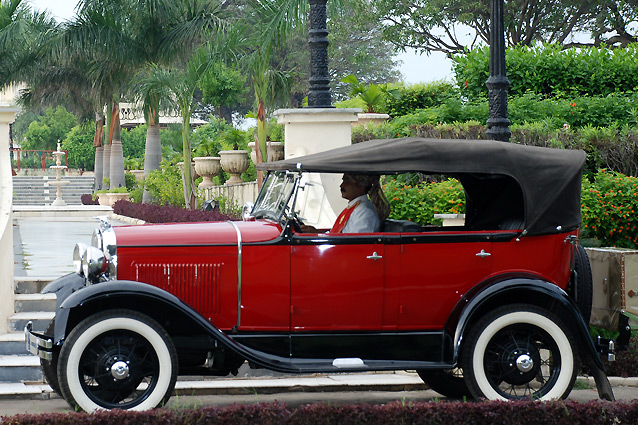
1930 Ford
Brief History
Having dominated the market for years, by 1925 Ford sales and production were going steadily downhill as a number of customers grew dissatisfied with the outdated engineering systems and design of their model, FORD T. This was in marked contrast to Chevrolet whose sales were increasing. The turning point came in December 1927 when Ford introduced the Model A, which featured new design and engineering concepts and was to be one of their greatest achievements. By the end of 1931 they had produced more than five million cars and even today, Ford Model A is one of the most collectable cars in the world. It is estimated that 500,000 Model A cars exist in private hands.
The House of Mewar acquired the Ford A, 70 years ago as its first owner. Its registration number is RJY-68.
About the Restoration
When restoration work started on the Model A, the Standard Phaeton, the car looked like a dilapidated shell with only chassis and engine. Restoration was to present a formidable challenge to those involved. All work carried out has been done in accordance with the original Ford A Restorer’s Guide. The entire body was removed from the Chassis (frame) before each piece of the bodywork was thoroughly checked for any damage, which was then repaired. The actual frame was also checked and sprayed with primer before being painted black. The entire body of the car was scrubbed before being painted. This required hand painting on each piece with original Milano red colour and black on the lower body.
Work was then undertaken on all the mechanical parts starting with the engine. The second stage involved detailed attention to the transmission, the steering box, the four hubs and a complete new wiring system. After reassembling the parts, the meticulous task of restoring the interior of the car was carried out. The leather car seats, door panels, folding top and side curtains were trimmed with black. Other original accessories were obtained by special order from the U.S.A to complement the age of the car. These included a flying quail, trunk and white wall tires, wing mirrors and stone guard. Work on the car has taken four years to complete and involved six mechanics in the specialised workshop of The Vintage & Classic Car Collection. Finally, the Model A, the Standard Phaeton has been restored to its former magnificence.
| Model | 1930 |
| Engine | 4 Cylinder "L Head" 40 hp |
| Transmission | 3+1 Speed (Manual) |
Tab 4
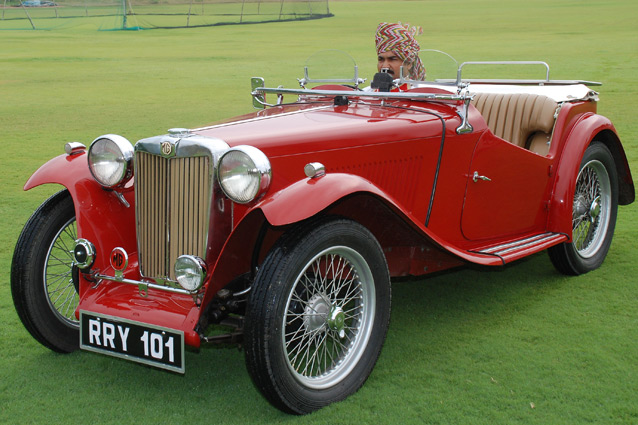
MG TC 1946
Brief History
After the war, Morris resumed car production in 1945 but concentrated their efforts on the new MG-TC which was a single two-seater car powered with 1250 c.c. four cylinder engine with twin S.U. carburetor. The car could reach a maximum speed of 70 mph taking 15 seconds to reach 50 mph. The car was stylish with wire wheels, a long bonnet and expansive radiator grill; slab petrol tank exposed at the back and of course its bright red colour that became a trade mark for sports cars. The TC rapidly became MG’s biggest selling model at the time and by 1949 the production lines were manufacturing 10,000 vehicles. A third of which were sold in Britain with some 2000 earmarked for the export market. In 1946, forty nine MG-TC were sold to India. Shriji Arvind Singh Mewar of Udaipur purchased the MG-TC from Hyderabad in early 70’s.
His Highness, Shriji Arvind Singh Mewar of Udaipur is a member of the MG Owners club.
About the Restoration
It has taken mechanics and technicians over two years (between 2002 – 2004) to restore the car to its former glory as the entire body of the car had to be dissembled. The old colour coating on the frame and body were softened using a propane torch and acid and then laboriously scrapped off by hand. The frame was sprayed with primer before being painted black. The bodywork was then taken to a blacksmith and checked for dents and cracks.
Both the doors were replaced before an extensive research was undertaken to find the exact bright MG red original colour. This was finally sourced through MG’s Club headquarters in the UK. Final painting and all the mechanical work was carried out by mechanics at The Palace, The Vintage & Classic Car Collection, Garden Hotel, Udaipur, Rajasthan, India.
Before completing the finishing touches, a total overhaul of the engine was required and many different parts had to be acquired to get the engine running again. These were sourced in the UK through NTG Motors, an MG specialist based in Ipswich.
A new walnut dashboard was made and other instruments displayed on the dashboard were again sourced from specialist MG garages in the UK. Chrome polish and painting were carried out before fixing the instruments in place. Both front seats were remade in keeping with the original design using beige coloured leather that would have been used in 1946.
| Engine | 4 Cylinder 1250 c.c. |
| Transmission | 4 speed manual |
| Top Speed | 75 mph |
Tab 5
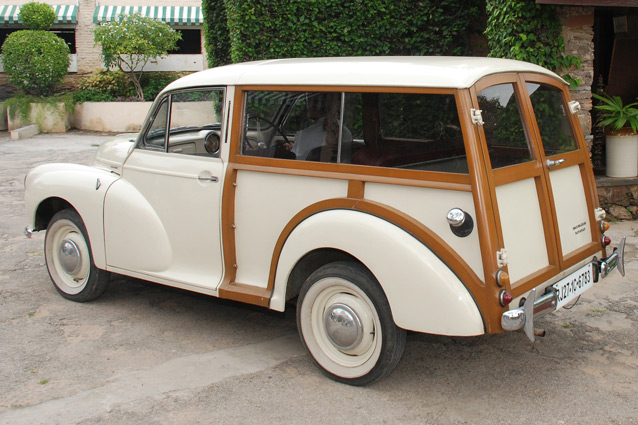
1959 Morris - Minor 1000 (Traveller)
Brief History
The Morris Minor was designed by Sir Alex Issigonis who later became famous for his creation of the Mini. Although it was designed for the mass market, production only ever reached 1.2 million between 1948 and 1971 when manufacturing stopped. The Morris Minor was considered a sporty and stylish car. This 1950 model has a split wind screen and low headlights that distinguish it from earlier models. Even before an extra four inches were added to its width, it could seat four comfortably.
About the Restoration
The Morris Minor was the first car to be restored in The Palace The Vintage & Classic Car Collection, Udaipur. The car had been badly neglected and had to be completely restored including repair to the body and paint work. All the leather upholstery has been replaced. Mechanics worked for nearly eight months on its restoration.
| Model | 1930 |
| Engine | 4 Cylinder "L Head" 40 hp |
| Transmission | 3+1 Speed (Manual) |
Car on Display
Tab 6
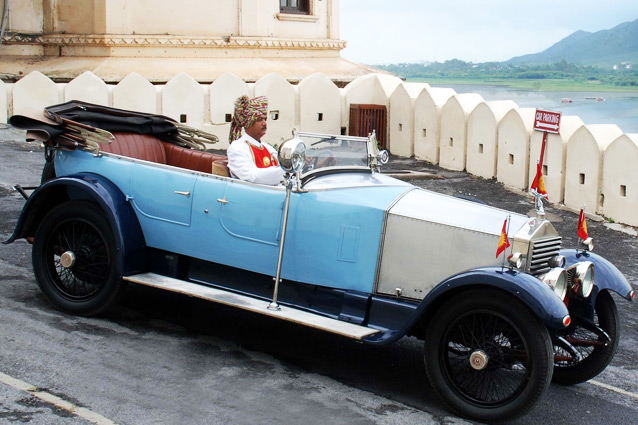
1924 Rolls Royce
Brief History
Between 1908 and 1940 the Rolls - Royce car was made in their Derby factory where the car itself was designed by Royce.
At this time (up until the end of the Second World War) the customer chose the body that suited his needs best and a coachbuilder was employed to supply it. Barker, of South Audley Street in London was one of the top coachbuilders at that time and they supplied the coachwork for GLK21 that was unique.
Barker gave an aerodynamic shape to the windscreen, which was innovative and also a very rare feature of contemporary bodies.
Chassis GLK21 was an early model that started life with rear wheel brakes only. It wasn’t until 1924 that the system was improved by the fitting of front wheel brakes and mechanical servo assistance.
This model was also equipped with headlamps that could be manually adjusted by a lever that was next to the driver. The attention to detail in these early pre-war luxury cars was superb.
About the Restoration
Rolls - Royce GLK 21 was one of the first Rolls - Royce cars acquired by The House of Mewar. The restoration work started in 1999 at The Palace The Vintage & Classic Car Collection, Udaipur, it was an extremely challenging undertaking! The project was supported by experts from Hofmanns of Henley UK, a specialist mechanical engineering workshop.
The car required a complete overhaul of the engine and gear box which was carried out in Udaipur with the help of Mr. Graham Ashley-Carter of Hofmanns of Henley and Mr. Andrew Wood, an engineering expert and founder of UK Rolls - Royce specialist company P & A Wood. A number of major parts including the radiator were sent to London for repair. New tires for the car were sourced from New Zealand.
Once the mechanical work and body repairs had been done, the car was painted in N. C powder blue. The mudguards were painted dark blue and the wheels black. All chrome work was re-plated and the seats reupholstered in leather. It has taken almost five years to complete this work.
The final phase involved a complete rewiring of the electrics and was carried out in October 2005 during a visit to Udaipur by Mr. Winston Teague and Mr. David Aston of Hoffmans of Henley. Soon after this work the car was fired up for the first time in many years and is now in regular use.
This car was awarded the 'Best of Class Category, Vintage Classic in the Cartier Travel with Style Concours' in November 2008.
| Model | 1924 |
| Chasis No. | GLK 21 |
| Engine No. | G1135 |
| Coach Work by | Barker |
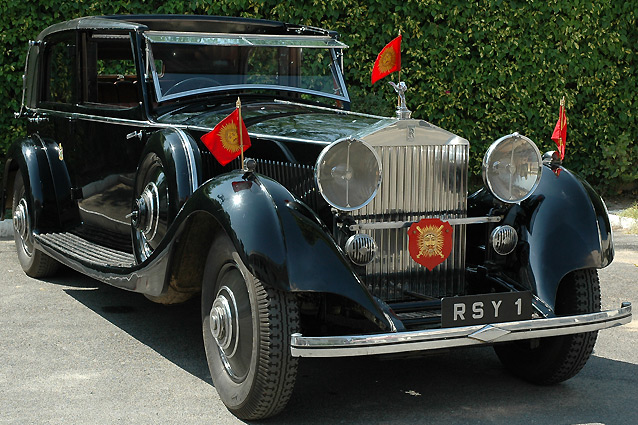
1934 Rolls Royce Phantom
Brief History
One hundred years ago, in 1904, a motor car enthusiast Charles Rolls and a well known engineer named Henry Royce met at the Midland hotel in Manchester, England. Royce agreed to manufacture a range of cars, which would be sold exclusively by Rolls. In 1906, the Rolls - Royce Company launched the "Silver Ghost". This six-cylinder luxury car was soon voted "BEST CAR IN THE WORLD" and it could handle rough, hilly terrain without any trouble and its engine was whisper smooth.
Subsequently, Rolls - Royce has gone on to become a world-renowned manufacturer not only of cars, but also of Aircraft engines both for military and civil aircrafts.
A Car fit for Kings
Rolls - Royce was the preferred car for indian Royalty between 1907 and 1947. A total of 36000 Rolls - Royce were produced in Britain out of which 1000 were exported to India.
The craze for the Luxury Car started in 1908 when the Maharaja of Gwalior bought a Rolls - Royce that won the Bombay-Kolhapur rally. Soon it became a status symbol. The Maharaja of Patiala owned 38 and Nawanagar had a garage that could hold 450 cars, including 8 Royce’s. The Nizam of Hyderabad, one of the world's richest men, had 50 Rolls - Royce's. In Baroda, the Maharaja had the interiors of his Rolls plated with 24-carat gold and fitted with solid silver door handles. A number of Rolls - Royce's were also adapted to serve on ‘Shikaar’ (Hunting). These had footboards on which servants could stand as the car raced through the jungle and were fitted with a high power " Shooting Lamp" to dazzle the animals.
The Rolls - Royce Phantom II 181 RY was used in the James Bond film “Octopussy” which was largely filmed in Udaipur.
About the Restoration
Amongst all 4 models, the 1934 ‘Phantom II’ 40-50hp is considered to be the most prized in the Rolls - Royce family of cars. The car is still in immaculate condition and has undergone restoration work including rewiring and clutch related work. The task of complete rewiring was an immense challenge for all concerned and involved procuring original wires with specific colour coding and working precisely to a diagram obtained from Rolls - Royce in the UK.
The wiring featuring a special cotton coating was obtained from Hoffman's of Henley, in the UK who also provided the technical support for the renovation work.
The Phantom II has a chassis lubrication system operated by a foot pump inside the car so the driver can lubricate the chassis as it is driven the car.
| Model | 1934 |
| Chasis No. | 181 RY |
| Engine No. | TT 65 |
| Coach Work by | Windovers London |
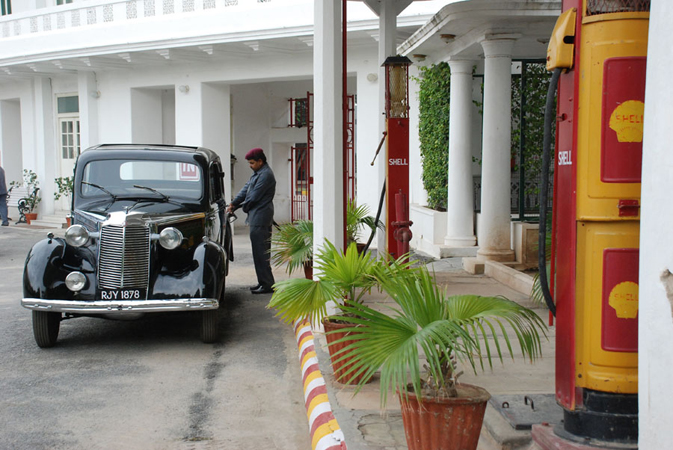
Vauxhall 12
Brief History
The House of Mewar is the first owner of the Vauxhall 12 (Deluxe). This car has an engine that runs with four cylinders, a Delco electric system, dry plate clutch and four speed transmission. With acceleration the car can reach a top speed of 0 to 50 miles in 23 seconds.
The Vauxhall 12 was considered one of the most brilliant pieces of design of its time that emerged on the British market. The design also incorporated technical innovation and the car was marketed at an affordable price during the post war years. With spacious seating, it gave high level performance using low fuel consumption.
From the lay viewpoint probably the most striking feature of the car is the use of combined body and chassis construction. This deluxe model has a sliding roof.
About the Restoration
The Vauxhall 12 (deluxe) was one of the first cars of The Vintage & Classic Car Collection to be restored in The Palace Workshop at the Garden Hotel. The Body has been painted black and the car now boasts beige interior upholstery.
Mechanics took a year to overhaul the car. Their work included mechanical and technical job of the engine, repairs to the body, painting and chrome plating. Original dashboard gauges were traced through a supplier in Pune and the tires in the original size was sourced through the Vauxhall Owners Club UK of which Shriji Arvind Singh Mewar of Udaipur is a member.
| A renovated Vauxhall - 12 Deluxe | |
| Year of Manufacture | 1947 |
| Registration No. | 1878 |
